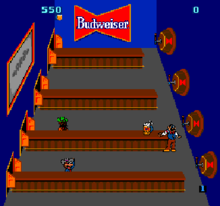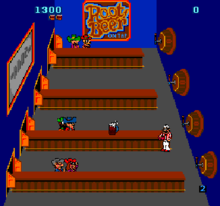Tapper (video game)
| Tapper | |
|---|---|
 | |
| Developer(s) | Marvin Glass and Associates |
| Publisher(s) | Bally Midway |
| Designer(s) | Steve Meyer (programming), Scott Morrison (graphics), Rick Hicaro (sound), Elaine Ditton (support) |
| Platform(s) | Arcade, Atari 2600, Atari 8-bit, ColecoVision, Commodore 64, ZX Spectrum, Amstrad CPC, BBC Micro, PC, Mobile phone, Xbox 360 (XBLA), iOS |
| Release | 1983 |
| Genre(s) | Action |
| Mode(s) | Up to 2 players, alternating turns |
Tapper, also known as Root Beer Tapper, is a 1983 arcade game released by Bally Midway. The goal of the game is to serve beer (or root beer) and collect empty mugs and tips.
Overview
Tapper puts the player in the shoes of a bartender. The player must serve eager, thirsty patrons before their patience expires.[1] The game was produced in association with Budweiser.[2]
Gameplay
The Tapper game screen features four bars. Patrons arrive periodically at the end of the bar opposite the player and demand drinks. The player must draw and serve drinks to the patrons as they slowly advance towards the player. If any customers reach the player's end of the bar, they grab the player-as-bartender and toss him out the far end of the bar, costing the player a life.[3]

The player serves customers by filling a mug at one of the four taps. Once the mug is full, the player releases the tap which automatically slides the mug towards the advancing customer. Customers catch mugs that are slid towards them, as long as they are not already drinking a beer, or otherwise distracted. If a mug is not caught by a customer (whether the customer is already drinking or distracted, or if there is no customer), then it falls off the bar on the other end, resulting in a loss of a life for the player. If a customer does catch the mug, though, then he or she is pushed back some amount towards the opposite end of the screen. The goal is to push the customer completely off the screen, but if they are not then they will stay and consume their drink in place. When a customer finishes his drink, he slides the empty mug back towards the player, after which the customer resumes his advance on the player. The player must collect the empty mugs before they reach the end of the bar and fall to the ground, as a mug falling to the ground costs a life.
Periodically, customers will leave tips on the bar for the player. These tips can be left at any place on the bar. The tip will appear after a specific number of empty mugs are released by the customers, and will appear wherever the customer who releases the required mug is standing. For example, in all levels, the first tip is left by the customer who returns the second empty mug, and will be left beside wherever this customer is standing. By collecting the tip, the player earns extra points and initiates "entertainment" for that level (dancing girls on the wild-west level, cheerleaders on the sports level, etc.). While the entertainment is active, some fraction of the customers will be distracted and stop advancing towards the player, but they will also stop catching mugs.
In order to complete a level, the player must clear the entire bar of customers. Once this is done, the player is presented with a short vignette in which the bartender draws a drink for himself, drinks it, then tosses the empty mug into the air with varying (usually humorous) results, such as kicking it and shattering it or having the mug fall atop his head and cover it.
As the game progresses, the customers appear more frequently, move faster along the bar, and are pushed back shorter distances when they catch their drinks. In addition, the maximum number of customers per bar gradually increases until every bar can have up to four customers at a time.
In between levels of different settings, the player is presented with a "challenge" round. In this segue, the player is presented with a single bar that has six cans of beer or root beer sitting on top of it. A masked villain shakes every can except one and then pounds on the bar, causing the cans to shuffle their positions. It is in essence a shell game. If any other shaken can is picked, it explodes in the bartender/soda jerk's face, after which the right can is revealed. If the player selects the unshaken can, the hero is shown smiling and a message reads "This Bud's For You" (on the Budweiser version) or "This one's for you" (on Root Beer Tapper), and the player is rewarded with extra points.
There are four settings for the game, each setting lasting for two to four levels. The settings of the game are:
- A western bar with cowboys (2 levels)
- A sports bar with athletes (3 levels)
- A punk rock bar with punk rockers (4 levels)
- A space bar with aliens (4 levels)
After completing all the levels, 13 in all, the player starts at the first again, harder than the first time through, and with some minor variations.

Originally sponsored by Anheuser-Busch, the first arcade versions sported a "Budweiser" motif (the Budweiser theme song was actually used in the arcade game). The machine was intended to be sold to bars with many of the cabinets designed to look like bars—complete with a brass rail footrest and drink holders. The very first machines had game controllers that were actual Budweiser beer tap handles, which were later replaced by smaller, cheaper, plastic "beer taps" with the Budweiser logo on them.[4]
Music
Music and sound effects on the original arcade version of "Tapper" were created by the game's sound designer, Rick Hicaro, an electronic game developer at Marvin Glass & Associates (MG&A) who also happened to be a musician. He used a proprietary sound synthesizer system developed at Marvin Glass & Associates to create all the sound effects and music. The system consisted of a "Synclavier II" sound synthesizer (a sophisticated, professional synthesizer consisting of a 16-bit mini-computer and synthesizer keyboard/sound manager), running custom sound development software written by Richard Ditton, a software engineer and video game developer at MG&A. The system interfaced directly to the actual arcade game system so that sounds were true to the capabilities of the hardware. It also allowed for rapid prototyping and testing of gameplay with full sound and music during the development of video games. Also, unlike other gaming development systems where the music was created note-by-note in programming code, music (and even sound effects) on the MG&A system could be played on the Synclavier's keyboard, recorded directly into memory, then burned directly into the gaming ROMs.
The sound effects themselves were modeled after cartoon sound effects and real-life sounds. All music was original and composed by Rick Hicaro, except for "Oh! Susanna" (old west bar, composed by Stephen Foster), "Buffalo Gals" (traditional American folk song) heard in the barroom scenes when the cartoon gals danced in the background, and the Budweiser theme heard in the bonus round.[5] The "Can-Can" by Jacques Offenbach was heard when a tip was collected and set off the onstage entertainment.
Versions

Several variants of the game were released, with similar gameplay but different graphics and music. The first was with Budweiser branding, followed in 1984 by Root Beer Tapper, which was developed specifically for arcades because the original version was construed as advertising alcohol to minors (since many of the games appeared in video game arcades).
The Tom Mix Software Company made a clone called Brewmaster for the TRS-80 Color Computer.
In 1984, Coleco made versions of Root Beer Tapper for their Colecovision game console. It also appeared on several other home systems including the Atari 2600, Atari 5200, Atari 8-bit, Commodore 64 and Apple II. The IBM PC version was designed by David James Ritchie.
Most of the home versions of Tapper featured the Mountain Dew logo, but retained the bartender character of the original arcade game instead of the soda jerk in Root Beer Tapper.
There are also some boards with Suntory branding, supposedly made by Sega[citation needed], which they deny.
In July 2000, Midway licensed Root Beer Tapper, along with other Williams Electronics games, to Macromedia for use in an online applet to demonstrate the power of the Shockwave web content platform, entitled Shockwave Arcade Collection. The conversion was created by Digital Eclipse. It is currently freely available to be played online.
Root Beer Tapper was included in the compilation Midway Arcade Treasures for PlayStation 2, Xbox, GameCube, and the PC, and the compilation Midway Arcade Origins for PlayStation 3 and Xbox 360.[6]
In 2005, Root Beer Tapper was one of the games included in the Midway Home Video Arcade produced by Big Electronic Games.
Root Beer Tapper is a leaderboard game on Gametap.
Root Beer Tapper was released on Microsoft's Xbox Live Arcade service for the Xbox 360 on February 7, 2007. This release adds high definition support, achievements, leaderboards, and new online and local co-op modes. This version has since been delisted.
On February 3, 2011, Warner Bros. Digital Distribution announced that they are working with Don Bluth and his game development company Square One Studios to release a modern reinterpretation of the game titled Tapper World Tour.
Included in the Neopets website's annual Altador Cup is a game called Slushie Slinger which bears striking similarities to Tapper.
Reception
Compute!'s Gazette called the Commodore version of Tapper "one of the most addictive games we've seen lately ... not only fun to play, but also immensely challenging, graphically entertaining, and full of action". The magazine stated that "it's a very well-designed strategy game", and concluded that it was "near the top in entertainment value".[7]
Legacy
The programming and art style are almost identical to a previous game called Domino Man, and the following game Timber. In fact, the main character in Timber is a rework of the main character in Tapper. The art is based on Mike Ferris, an artist who taught Scott Morrison art.[8]
The game was also an inspiration for the programmers of Plants vs. Zombies, which presents several rows of characters to defend against.[citation needed]
Tapper is one of the featured games in Disney's Wreck-It Ralph. After the video arcade closes for the night, characters from other games often gather in the bar to have a drink and relax. Wreck-It Ralph visits the bartender (voiced by Maurice LaMarche) to see if he knows of any games that would offer out medals. One wall of the bar displays Sardi's-like caricature pictures of video game celebrities as well as a caricature picture of the film's director Rich Moore.[9] Around the end of the film, the bartender is among the video game characters that attend Fix-It Felix Jr. and Sergeant Calhoun's wedding.
References
- ^ CLASSIC GAMES REVISITED - Tapper (Atari 2600) review at Univision [dead link]
- ^ Undertow, CGR. "ROOT BEER TAPPER for Arcade Video Game Review".
- ^ Game entry at Giantbomb
- ^ Rick Hicaro, former Marvin Glass & Associates employee; music composer/sound developer for Tapper
- ^ Written by R. Hicaro, former Marvin Glass & Associates employee and music composer/sound developer for Tapper
- ^ http://www.ign.com/articles/2012/11/14/midway-arcade-origins-review
- ^ "Tapper". Compute!'s Gazette. January 1985. p. 113. Retrieved 6 July 2014.
- ^ Retro Gamer magazine, issue 74. "The making of ... Tapper", page 67
- ^ "The Art of Bobby Pontillas". Retrieved 2013-03-30.
External links
- Tapper at the Killer List of Videogames
- Template:StrategyWiki
- Video of the complete game
- Screenshots of a Tapper arcade machine at BasementArcade
- The DOS version of Tapper can be played for free in the browser at the Internet Archive
- The Atari 2600 version of Tapper can be played for free in the browser at the Internet Archive
